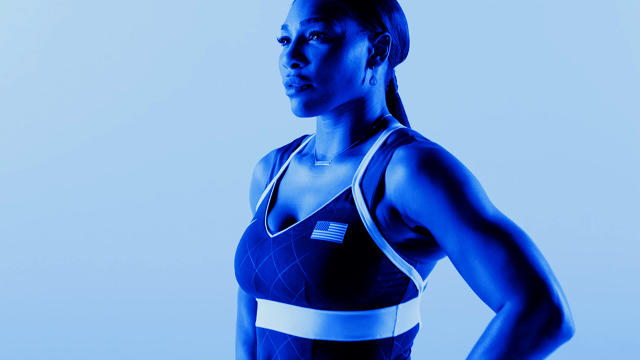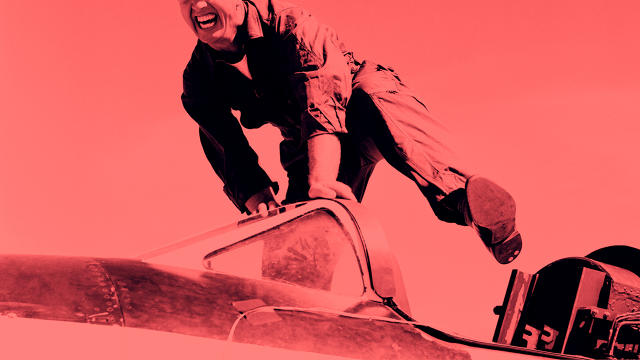Αrt2523 Τριτη 28 Φεβρουαρίου 2017
No Guts, No Glory: Five Traits Brands Need In 2017
BSSP chief strategy officer Edward Cotton outlines what modern brands need today for successful growth.
[Photo: Flickr user Michael Neubert]EDWARD COTTON
Today’s brands and their managers are not short on challenges—navigating the rapidly fragmenting media universe, maintaining privacy, increasing consumer control, battling for attention, keeping up with the digital transformation, and even understanding the role brands should play in society. Managing these issues on behalf of brands now demands the perfectly balanced combination of left- and right-brain skills.
Five traits will distinguish the star brands and their marketers from the merely average and also-rans in 2017 and beyond. These disciplines are critical for brands, and the marketers behind them, that want to thrive.

Serena Williams featured in BSSP's Mini Olympics Games Campaign
GUTS
Changing the status quo by breaking category norms and creating different brand experiences demands a high level of confidence and the guts to go beyond what is expected. But there is also another important aspect to having guts these days—having the confidence to own up to the fact that you don’t know everything. Given the complexity of today’s marketing environment, that is understandable. However, corporate politics and ego make it tough for executives to admit to their knowledge gaps. It is high time to break down this barrier.
Some examples of guts in action include Unilever’s acquisition of Dollar Shave Club brought this disruptor into the fold of a conservative CPG company, changing the dynamics of how all its brands think about the marketplace. Adidas, which has spent an eternity in Nike’s shadow, made the bold decision to work with Kanye West—just one result of a shift in strategy that included moving decision-making for the U.S. market from Germany to the U.S. itself. And Instagram transformed itself to fight off the challenge from Snapchat.
Beyond the big, transformative changes, brands—if they want to capture consumer attention—are going to have to take risks with their communication. In 2016, Mondelez produced its own 60-minute show featuring a skydiver jumping out of a plane without a parachute.
Laura Henderson, the now former global head of content at Mondelez, summed up the development experience as "commercialized creativity," which she described as follows: "In this new world, not only do we need to be more creative, in terms of what we do, but also in how to do it and how we get there. You can't bluff it. You can't just do it on your own. You need the support of the entire organization."

[Photo: Flickr user ellyn.]
RIGOR
Guts, intuition, and bravery are nothing without the rigor to support these actions. Brands are getting lost because of the temptation to chase the next new shiny object, and because of an overemphasis on short-term results versus long-term brand building. Brands need the discipline to be clear about who they are and what they stand for. Only with this level of focus can brands manage the challenge of complexity.
Unilever CMO Keith Weed recently said that the rapid fragmentation of media makes brand integration harder than ever, and that just thinking about it keeps him up at night. Weed’s concerns seem to be borne out by recent research from Havas showing that global consumers think 60% of branded content is just clutter.
Rigor is needed with the growing accessibility of big data. The trick is to use it in ways that can directly impact the business. We are starting to see a few brands mastering this. For example, Netflix has been using big data for years to help develop and buy programming, but it’s also using it to understand the precise moments in plot lines that get viewers hooked. IBM has been using Watson to analyze big data and help with all its programmatic media buys. Spotify crunches data from 2 billion playlists to come up with its eagerly anticipated Discover Weekly playlists.
There is clearly a need for brands to be much more demanding with data from third parties. It is madness that two-thirds of advertisers on mobile can’t measure their ROI. Marc Pritchard of P&G told the media industry earlier this year that it’s just not enough to measure—they also have to question because, in many cases, the performance numbers brands are being given by media owners cannot be trusted. Airbnb CMO Jonathan Mildenhall echoed Pritchard’s sentiment when he highlighted how important it was for marketers not to abdicate their responsibility and accountability to outsiders. These issues become increasingly important with the rapid adoption of zero-based budgeting. Clients are desperate to have solid evidence to prove their case for budgets, because under this new system every dollar has to be fought for and justified.
IMAGINATION
We live in a world where, increasingly, anything is possible. But many corporate cultures are great at squashing imagination. Without the ability to imagine, brands quickly lose relevance. They need creativity to thrive. Since creativity is subjective, having a benchmark is key. That’s why Heineken developed its own visual ladder to evaluate internal creativity as well as work from outside the organization.
Consider these examples of imagination in action. Amazon is always looking for new ways to engage its customers, including the development of Alexa and Alexa Voice Service, the launching of new retail experiences, and the implementation of regular enhancements to its Prime membership program. Absolut created Absolut Labs, an "idea incubator and think tank" based in New York, to identify new technologies that can transform nightlife. Hasbro has been involved in the entertainment business for quite a while, but recently stepped up its efforts in a multi-film deal with Paramount Pictures that includes working with high-caliber writers such as Michael Chabon. AccorHotels, the European hotel group, has plans to take on Airbnb—not with another hotel, but with Jo&Joe, its own take on the future of hospitality that includes a space that is part hostel, part apartment, and part collaborative workspace.

[Photo: Flickr user Danielle Henry]
SOUL
The ability to understand your customers and their needs is paramount to future success. This might be about using data and personalization to provide customers with what they need, but rely too much on data and you’ll miss the nuances, and the reasons why. Given the U.K. Brexit referendum and U.S. election results, our approaches to understanding people have been called into question.
Research published earlier this year from Brand Keys found consumers’ expectations of brands have increased 23% in a year from 2016, while brands have improved their offerings by only 4%, leaving a considerable gap. Expectations grew most in online networking and entertainment (+35%), technology (+32%), cosmetics (+28%), and personal products & CPG (+26%). Closing this gap requires the ability to empathize, listen, and understand. Most importantly, however, it requires the ability to learn what customers are really looking for, in order to make them an integral part of the process.
Brands are finding ways of getting closer to their customers. Lego wouldn’t be where it is today without its former CEO stepping out of his big office and going out into the real world and engaging with his customers in their homes and at fan events. At the beginning of 2016, Ford announced it was remaking itself as a user-centric company and would be making ethnography, not traditional market research, a key pillar in its transformation. Adidas experiments with dark social, using messenger apps to create dedicated social channels for fan influencers and giving them access to athletes, products, and exclusive content.
Soul also means a cultural understanding, the ability to know and feel not only where the world is heading but also your place in it. This is playing out right now with brands stepping into the political arena, with some having every right to be there while others are called out as mistaken opportunists. Last year the Ikea Foundation designed a better shelter for refugees, an idea and an action that are in keeping with the brand’s competency and mission.

[Photo: Flickr user NASA on the Commons]
AGILITY
Brands now have to respond faster and bring products to market at a swift pace. Technology is speeding up the information flow, shareholders want to keep costs down, consumers’ expectations are rising, and then there is always the looming threat of competition. Brands need to be flexible and adaptive to respond at speed to opportunities and challenges.
Some categories and brands are becoming more agile and responsive. Big food companies are rapidly transforming themselves by reformulating ingredients and acquiring small brands to meet the healthier standards consumers now demand. Customers of Tommy Hilfiger, Burberry, and Tom Ford do not have to wait months for items from the catwalk. They can now purchase them immediately after the show. Domino’s is so attuned to tech trends it is almost becoming a tech company that happens to deliver pizza. Drones and bots are the latest channels for pizza delivery they’re working on. CPG companies are accelerating the time from idea to launch from years to months. For example, Unilever shortened its product-development time to six months for a recent Hellman’s line extension and to four months for the launch of an ice cream.
Marketing has never been easy, and today it is tougher than ever. By mastering all of the five traits outlined, brands and those managing them will not only be able to endure, but also grow.
Edward Cotton is chief strategy officer at agency BSSP, and chair of the 4A’s Strategy Council.
www.fotavgeia.blogspot.com
No Guts, No Glory: Five Traits Brands Need In 2017
BSSP chief strategy officer Edward Cotton outlines what modern brands need today for successful growth.
[Photo: Flickr user Michael Neubert]EDWARD COTTON
Today’s brands and their managers are not short on challenges—navigating the rapidly fragmenting media universe, maintaining privacy, increasing consumer control, battling for attention, keeping up with the digital transformation, and even understanding the role brands should play in society. Managing these issues on behalf of brands now demands the perfectly balanced combination of left- and right-brain skills.
Five traits will distinguish the star brands and their marketers from the merely average and also-rans in 2017 and beyond. These disciplines are critical for brands, and the marketers behind them, that want to thrive.

Serena Williams featured in BSSP's Mini Olympics Games Campaign
GUTS
Changing the status quo by breaking category norms and creating different brand experiences demands a high level of confidence and the guts to go beyond what is expected. But there is also another important aspect to having guts these days—having the confidence to own up to the fact that you don’t know everything. Given the complexity of today’s marketing environment, that is understandable. However, corporate politics and ego make it tough for executives to admit to their knowledge gaps. It is high time to break down this barrier.
Some examples of guts in action include Unilever’s acquisition of Dollar Shave Club brought this disruptor into the fold of a conservative CPG company, changing the dynamics of how all its brands think about the marketplace. Adidas, which has spent an eternity in Nike’s shadow, made the bold decision to work with Kanye West—just one result of a shift in strategy that included moving decision-making for the U.S. market from Germany to the U.S. itself. And Instagram transformed itself to fight off the challenge from Snapchat.
Beyond the big, transformative changes, brands—if they want to capture consumer attention—are going to have to take risks with their communication. In 2016, Mondelez produced its own 60-minute show featuring a skydiver jumping out of a plane without a parachute.
Laura Henderson, the now former global head of content at Mondelez, summed up the development experience as "commercialized creativity," which she described as follows: "In this new world, not only do we need to be more creative, in terms of what we do, but also in how to do it and how we get there. You can't bluff it. You can't just do it on your own. You need the support of the entire organization."

[Photo: Flickr user ellyn.]
RIGOR
Guts, intuition, and bravery are nothing without the rigor to support these actions. Brands are getting lost because of the temptation to chase the next new shiny object, and because of an overemphasis on short-term results versus long-term brand building. Brands need the discipline to be clear about who they are and what they stand for. Only with this level of focus can brands manage the challenge of complexity.
Unilever CMO Keith Weed recently said that the rapid fragmentation of media makes brand integration harder than ever, and that just thinking about it keeps him up at night. Weed’s concerns seem to be borne out by recent research from Havas showing that global consumers think 60% of branded content is just clutter.
Rigor is needed with the growing accessibility of big data. The trick is to use it in ways that can directly impact the business. We are starting to see a few brands mastering this. For example, Netflix has been using big data for years to help develop and buy programming, but it’s also using it to understand the precise moments in plot lines that get viewers hooked. IBM has been using Watson to analyze big data and help with all its programmatic media buys. Spotify crunches data from 2 billion playlists to come up with its eagerly anticipated Discover Weekly playlists.
There is clearly a need for brands to be much more demanding with data from third parties. It is madness that two-thirds of advertisers on mobile can’t measure their ROI. Marc Pritchard of P&G told the media industry earlier this year that it’s just not enough to measure—they also have to question because, in many cases, the performance numbers brands are being given by media owners cannot be trusted. Airbnb CMO Jonathan Mildenhall echoed Pritchard’s sentiment when he highlighted how important it was for marketers not to abdicate their responsibility and accountability to outsiders. These issues become increasingly important with the rapid adoption of zero-based budgeting. Clients are desperate to have solid evidence to prove their case for budgets, because under this new system every dollar has to be fought for and justified.
IMAGINATION
We live in a world where, increasingly, anything is possible. But many corporate cultures are great at squashing imagination. Without the ability to imagine, brands quickly lose relevance. They need creativity to thrive. Since creativity is subjective, having a benchmark is key. That’s why Heineken developed its own visual ladder to evaluate internal creativity as well as work from outside the organization.
Consider these examples of imagination in action. Amazon is always looking for new ways to engage its customers, including the development of Alexa and Alexa Voice Service, the launching of new retail experiences, and the implementation of regular enhancements to its Prime membership program. Absolut created Absolut Labs, an "idea incubator and think tank" based in New York, to identify new technologies that can transform nightlife. Hasbro has been involved in the entertainment business for quite a while, but recently stepped up its efforts in a multi-film deal with Paramount Pictures that includes working with high-caliber writers such as Michael Chabon. AccorHotels, the European hotel group, has plans to take on Airbnb—not with another hotel, but with Jo&Joe, its own take on the future of hospitality that includes a space that is part hostel, part apartment, and part collaborative workspace.

[Photo: Flickr user Danielle Henry]
SOUL
The ability to understand your customers and their needs is paramount to future success. This might be about using data and personalization to provide customers with what they need, but rely too much on data and you’ll miss the nuances, and the reasons why. Given the U.K. Brexit referendum and U.S. election results, our approaches to understanding people have been called into question.
Research published earlier this year from Brand Keys found consumers’ expectations of brands have increased 23% in a year from 2016, while brands have improved their offerings by only 4%, leaving a considerable gap. Expectations grew most in online networking and entertainment (+35%), technology (+32%), cosmetics (+28%), and personal products & CPG (+26%). Closing this gap requires the ability to empathize, listen, and understand. Most importantly, however, it requires the ability to learn what customers are really looking for, in order to make them an integral part of the process.
Brands are finding ways of getting closer to their customers. Lego wouldn’t be where it is today without its former CEO stepping out of his big office and going out into the real world and engaging with his customers in their homes and at fan events. At the beginning of 2016, Ford announced it was remaking itself as a user-centric company and would be making ethnography, not traditional market research, a key pillar in its transformation. Adidas experiments with dark social, using messenger apps to create dedicated social channels for fan influencers and giving them access to athletes, products, and exclusive content.
Soul also means a cultural understanding, the ability to know and feel not only where the world is heading but also your place in it. This is playing out right now with brands stepping into the political arena, with some having every right to be there while others are called out as mistaken opportunists. Last year the Ikea Foundation designed a better shelter for refugees, an idea and an action that are in keeping with the brand’s competency and mission.

[Photo: Flickr user NASA on the Commons]
AGILITY
Brands now have to respond faster and bring products to market at a swift pace. Technology is speeding up the information flow, shareholders want to keep costs down, consumers’ expectations are rising, and then there is always the looming threat of competition. Brands need to be flexible and adaptive to respond at speed to opportunities and challenges.
Some categories and brands are becoming more agile and responsive. Big food companies are rapidly transforming themselves by reformulating ingredients and acquiring small brands to meet the healthier standards consumers now demand. Customers of Tommy Hilfiger, Burberry, and Tom Ford do not have to wait months for items from the catwalk. They can now purchase them immediately after the show. Domino’s is so attuned to tech trends it is almost becoming a tech company that happens to deliver pizza. Drones and bots are the latest channels for pizza delivery they’re working on. CPG companies are accelerating the time from idea to launch from years to months. For example, Unilever shortened its product-development time to six months for a recent Hellman’s line extension and to four months for the launch of an ice cream.
Marketing has never been easy, and today it is tougher than ever. By mastering all of the five traits outlined, brands and those managing them will not only be able to endure, but also grow.
Edward Cotton is chief strategy officer at agency BSSP, and chair of the 4A’s Strategy Council.
www.fotavgeia.blogspot.com


Δεν υπάρχουν σχόλια:
Δημοσίευση σχολίου